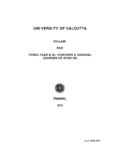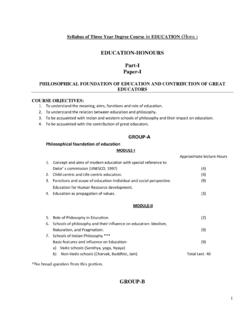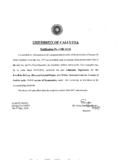Transcription of UNIVERSITY OF CALCUTTA
1 1 UNIVERSITY OF CALCUTTA CBCS SYLLABUS OF ZOOLOGY 2018 F O R THREE-YEAR HONOURS DEGREE COURSE OF STUDIES 2 Outline Structure of CBCS Curriculum for Zoology (Hons), PART I; SEM I Subject Code Name of Paper Theory Practical Internal assessment CC 1 Non Chordata I (Protists to Pseudocoelomates) 50 30 20 CC 2 Molecular Biology 50 30 20 PART I; SEM II CC 3 Non Chordata II (All Coelomate Phyla) 50 30 20 CC 4 Cell Biology 50 30 20 PART II; SEM III CC 5 Chordata 50 30 20 CC 6 Animal Physiology: Controlling & Co-ordinating System 50 30 20 CC 7 Fundamentals of Biochemistry 50 30 20 SEC-A (1/2) Apiculture / Sericulture 80 NA 20 PART II; SEM IV CC 8 Comparative Anatomy of Vertebrate 50 30 20 CC 9 Animal Physiology: Life sustaining system 50 30 20 CC 10 Immunology 50 30 20 SEC- B(1/2) Aquarium Fisheries/ Medical Diagnosis 80 NA 20 PART III; SEM V CC 11 Ecology 50 30 20 CC 12 Principle of Genetics 50 30 20 DSE A(1/2) Parasitology/Biology of Insect 50 30 20 DSE B (1/2) Endocrinology/Reproductive Biology 50 30 20 PART III; SEM VI CC 13 Developmental Biology 50 30 20 CC 14 Evolutionary Biology 50 30 20 DSE A (1/2) Animal Biotechnology/Animal Cell Biotechnology 50 30 20 DSE B (1/2) Animal Behaviour & Chronology/Fish & Fisheries 50 30 20 Abbreviations: CC: Core Course; DSE A/B: Discipline Specific Elective A/B; SEC A/B: Skill Enhancement Course.
2 3 SUBJECT/PAPER CODE FORMAT 1. Subject Code: ZOO 2. Honours Code: A 3. Course Code: a) Core Course: CC b) Discipline Specific Elective: DSE-A/DSE-B c) Skill Enhancement Course: SEC-A/SEC-B 4. Semester Code: 1/2/3/4/5/6 5. Paper No. Code: 1/2 6. Paper Component Code: a) Theory: TH, b) Practical: P INDEX CBCS ZOOLOGY (HONOURS), Papers & Their Codes Code Paper Page Core Course ZOOA-CC1-1-TH Non- Chordates I (Protista to Pseudocoelomate) Theory 5 ZOOA-CC1-1-P Non- Chordates I Lab 6 ZOOA-CC1-2-TH Molecular Biology 6 ZOOA-CC1-2-P Molecular Biology Lab 7 ZOOA-CC2-3-TH Non-Chordate II (Coelomate Phyla) Theory 7 ZOOA-CC2-3-P Non-Chordate II Lab 8 ZOOA-CC2-4-TH Cell Biology Theory 8 ZOOA-CC2-4-P Cell Biology Lab 9 ZOOA-CC3-5-TH Chordata Theory 9 ZOOA-CC3-5-P Chordata Lab 10 ZOOA-CC3-6-TH Animal Physiology: Controlling & Co-ordinating system Theory 11 ZOOA-CC3-6-P Animal Physiology.
3 Controlling & Co-ordinating system Lab 11 ZOOA-CC3-7-TH Fundamental of Biochemistry Theory 12 ZOOA-CC3-7-P Fundamental of Biochemistry Lab 13 ZOOA-CC4-8-TH Comparative Anatomy of Vertebrate Theory 13 ZOOA-CC4-8-P Comparative Anatomy of Vertebrate Lab 14 ZOOA-CC4-9-TH Animal Physiology: Life Sustaining System Theory 14 ZOOA-CC4-9-P Animal Physiology: Life Sustaining System Lab 15 ZOOA-CC4-10-TH Immunology Theory 15 ZOOA-CC4-10-P Immunology Lab 16 ZOOA-CC5-11-TH Ecology Theory 16 ZOOA-CC5-11-P Ecology Lab 17 4 ZOOA-CC5-12-TH Principle of Genetics Theory 17 ZOOA-CC5-12-P Principle of Genetics Lab 18 ZOOA-CC6-13-TH Developmental Biology Theory 18 ZOOA-CC6-13-P Developmental Biology Lab 19 ZOOA-CC6-14-TH Evolutionary Biology Theory 19 ZOOA-CC6-14-P Evolutionary Biology Practical 20 Discipline Specific Electives ZOOA-DSE(A)-5-1-TH Parasitology Theory 21 ZOOA-DSE(A)-5-1-P Parasitology Lab 21 ZOOA-DSE(A)-5-2-TH Biology of Insect Theory 22 ZOOA-DSE(A)-5-2-P Biology of Insect Lab 23 ZOOA-DSE(B)-5-1-TH Endocrinology Theory 23 ZOOA-DSE(B)-5-1-P Endocrinology Lab 24 ZOOA-DSE(B)-5-2-TH Reproductive Biology Theory 24 ZOOA-DSE(B)-5-2-P Reproductive Biology Lab 25 ZOOA-DSE(A)
4 -6-1-TH Animal Cell Biotechnology Theory 25 ZOOA-DSE(A)-6-1-P Animal Cell Biotechnology Lab 26 ZOOA-DSE(A)-6-2-TH Animal Biotechnology Theory 26 ZOOA-DSE(A)-6-2-P Animal Biotechnology Lab 27 ZOOA-DSE(B)-6-1-TH Animal Behaviour & Chronobiology Theory 27 ZOOA-DSE(B)-6-1-P Animal Behaviour & Chronobiology Lab 28 ZOOA-DSE(B)-6-2-TH Fish & Fishery Theory 28 ZOOA-DSE(B)-6-2-P Fish & Fishery Lab 29 Skill Enhancement Course ZOOA-SEC(A)-3-1-TH Apiculture 29 ZOOA-SEC(A)-3-2-TH Sericulture 30 ZOOA-SEC(A)-4-1-TH Aquarium Fishery 31 ZOOA-SEC(A)-4-2-TH Medical Diagnosis 31 5 PART I: SEMESTER 1 CORE COURSE 1. Non-Chordates I ZOOA-CC1-1-TH Full Marks 50 4 Credits 50 Hours Non-Chordates I: Protists to Pseudocoelomates Unit 1: Basics of Animal Classification 4 Definitions: Classification, Systematics and Taxonomy; Taxonomic Hierarchy, Taxonomic types Codes of Zoological Nomenclature; Principle of priority; Synonymy and Homonymy; Concept of classification three kingdom concept of Carl Woese, 1977 and five kingdom concept of Whittaker, 1969 Unit 2: Protista and Metazoa 15 Protozoa General characteristics and Classification up to phylum (according to Levine et.)
5 Al., 1980) Locomotion in Euglena, Paramoecium and Amoeba; Conjugation in Paramoecium. Life cycle and pathogenicity of Plasmodium vivax and Entamoeba histolytica Metazoa Evolution of symmetry and segmentation of Metazoa Unit 3: Porifera 6 General characteristics and Classification up to classes (Ruppert and Barnes, 1994, 6th Ed.); Canal system and spicules in sponges Unit 4: Cnidaria 10 General characteristics and Classification up to classes (Ruppert and Barnes, 1994, 6th Ed.), Metagenesis in Obelia; Polymorphism in Cnidaria; Corals and coral reef diversity, Role of symbiotic algae in reef formation. Conservation of coral and coral reefs. Unit 5: Ctenophora 2 General characteristics Unit 6: Platyhelminthes 6 General characteristics and Classification up to classes (Ruppert and Barnes, 1994, 6th Ed.) Life cycle and pathogenicity and control measures of Fasciola hepatica and Taenia solium Unit 7: Nematoda 7 General characteristics and Classification up to classes (Ruppert and Barnes, 1994, 6th Ed.
6 Life cycle, and pathogenicity and control measures of Ascaris-lumbricoides and Wuchereria-bancrofti Parasitic adaptations in helminthes 6 Non-Chordates I Lab; ZOOA-CC-1-1-P Non-Chordates I: Protists to Pseudocoelomates Full Marks 30 60 Hours 2 credits List of Practical 1. Study of whole mount of Euglena, Amoeba and Paramoecium 2. Identification with reason & Systematic position of Amoeba, Euglena, Entamoeba, Paramecium, Plasmodium, Balantidium, Vorticella (from the prepared slides) 3. Identification with reason & Systematic position of Sycon, Poterion (Neptune s Cup), Obelia, Physalia, Aurelia, Gorgonia, Metridium, Pennatula, Madrepora, Fasciola hepatica, Taenia solium and Ascaris lumbricoides. 4. Staining/mounting of any protozoa/helminth from gut of Periplaneta sp.
7 CORE COURSE 2: Molecular Biology ZOOA-CC1-2-TH Full Marks 50 4 Credits 50 Hours Unit 1: Nucleic Acids 3 Salient features of DNA, Chargaff s Rule, Hypo and Hyperchromic shift. Watson and Crick Model of DNA. RNA types & Function. Unit 2: DNA Replication 9 Mechanism of DNA Replication in Prokaryotes, Prove that replication is Semi-conservative, bidirectional and discontinuous, RNA priming, Replication of telomeres. Unit 3: Transcription 9 Mechanism of Transcription in prokaryotes and eukaryotes, Transcription factors, Difference between prokaryotic and eukaryotic transcription. Unit 4: Translation 9 Genetic code, Degeneracy of the genetic code and Wobble Hypothesis. Mechanism of protein synthesis in prokaryotes. Unit 5: Post Transcriptional Modifications and Processing of Eukaryotic RNA 8 Capping and Poly A tail formation in mRNA; Split genes: concept of introns and exons, splicing mechanism, alternative splicing and RNA editing 7 Unit 6: Gene Regulation 7 Regulation of Transcription in prokaryotes: lac operon and trp operon; Regulation of Transcription in eukaryotes: Activators, enhancers, silencer, repressors, miRNA mediated gene silencing.
8 Epigenetic Regulation: dna methylation , Histone methylation & Acetylation. Unit 7: DNA Repair Mechanisms 2 Types of DNA repair mechanisms, RecBCD model in prokaryotes, nucleotide and base excision repair, SOS repair Unit 8: Molecular Techniques 3 PCR, Western and Southern blot, Northern Blot Molecular Biology Lab; ZOOA-CC-1-2-P Full Marks 30 60 Hours 2 Credits List of Practical 1. Demonstration of polytene and lampbrush chromosome from photograph 2. Isolation and quantification of genomic DNA from goat liver. 3. Agarose gel electrophoresis for DNA. 4. Histological staining of DNA and RNA in prepared slides PART I: SEMESTER 2 CORE COURSE 3: Non-Chordates II Coelomates ZOOA-CC2-3-TH Full Marks 50 4 Credits 50 Hours Unit 1: Introduction 2 Evolution of coelom Unit 2: Annelida 10 General characteristics and Classification up to classes (Ruppert and Barnes, 1994) Excretion in Annelida through nephridia; Metamerism in Annelida.
9 Unit 3: Arthropoda 16 General characteristics and Classification up to classes (Ruppert and Barnes, 1994); Insect Eye (Cockroach only). Respiration in Prawn and Cockroach; Metamorphosis in Lepidopteran Insects; Social life in Termite Unit 4: Onychophora 2 General characteristics and Evolutionary significance 8 Unit 5: Mollusca 10 General characteristics and Classification up to classes (Ruppert and Barnes, 1994); Nervous system in Pila sp. Torsion in Gastropoda. Feeding and respiration in Pila sp. Unit 6: Echinodermata 8 General characteristics and Classification up to classes (Ruppert and Barnes, 1994); Water-vascular system in Asterias. Echinoderm larva and affinities with chordates Unit 7: Hemichordata 2 General characteristics of phylum Hemichordata. Relationship with non-chordates and chordates Non-Chordates II Lab, ZOOA-CC-2-3-P Full Marks 30 2 Credits List of Practical 1.
10 Study of following specimens: a. Annelids - Aphrodite, Nereis, Chaetopterus, Earthworm, Hirudinaria b. Arthropods - Limulus, Palaemon, Balanus, Eupagurus, Scolopendra, Peripatus, Silkworm life history stages, Termite members of a colony and Honey bee members of the colony c. Molluscs - Dentalium, Patella, Chiton, Pila, Achatina, Pinctada, Sepia, Octopus, Nautilus d. Echinoderms - Asterias, Ophiura, Clypeaster, Echinus, Cucumaria and Antedon 2. Anatomy study: Nervours system, Reproductive system (Male & female), Mouth parts & Salivary apparatus in Periplaneta sp. PART I: SEMESTER 2 CORE COURSE 4: Cell Biology ZOOA-CC2-4-TH Full Marks 50 4 Credits 50 Hours Unit 1: Plasma Membrane 7 Ultra-structure and composition of Plasma membrane: Fluid mosaic model, Transport across membrane - Active and Passive transport, Facilitated transport, Cell junctions: Tight junctions, Gap junctions, Desmosomes Unit 2: Cytoplasmic organelles I 5 Structure and Functions: Endoplasmic Reticulum, Golgi Apparatus, Lysosomes; Protein sorting and mechanisms of vesicular transport Unit 3: Cytoplasmic organelles II 7 Mitochondria: Structure, Semi-autonomous nature, Endosymbiotic hypothesis Mitochondrial Respiratory Chain, Chemiosmotic hypothesis.









